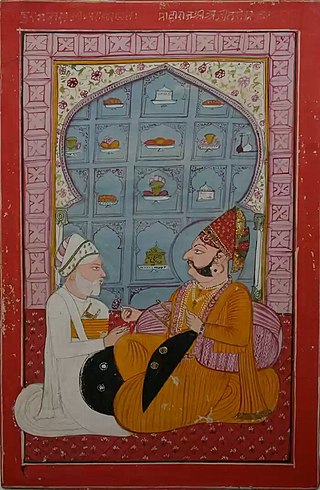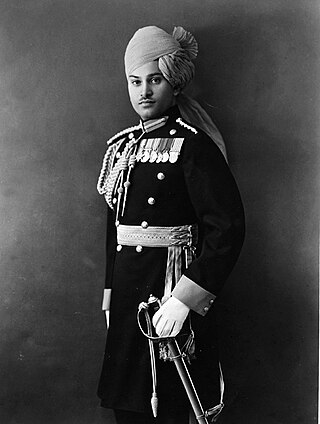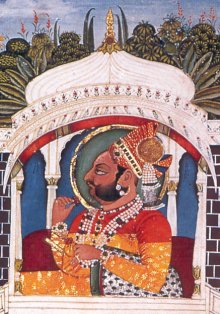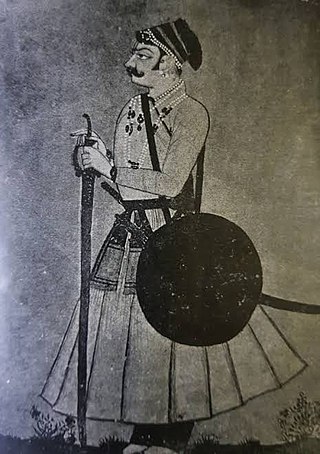
Marwar is a region of western Rajasthan state in North Western India. It lies partly in the Thar Desert. The word 'maru' is Sanskrit for desert. In Rajasthani languages, "wad" means a protected area. English translation of the word 'marwar' is the region protected by desert.

Ajit Singh Rathore was the ruler of Marwar region in the present-day Rajasthan and the son of Jaswant Singh Rathore.
Kuchesar was a Zamindari Estate of Dalal Jats during the British Raj. It is situated off the NH 24 in what is now of Bulandshahr district, Uttar Pradesh, India, 80 kilometres (50 mi) from Delhi.

Durgadas Rathore was the Rathore Rajput General of the Kingdom of Marwar. He is credited with having preserved the rule of the Rathore dynasty over Marwar, India, following the death of Maharaja Jaswant Singh in the 17th century. In doing so he had to defy Aurangzeb, a Mughal emperor. He commanded the Rathore forces during the Rajput War (1679–1707) and played a major role in the Rajput Rebellion (1708–1710) which became one of the main reason of decline of Mughal Empire. He was elected as the leader of the revolt along with Raja Jai Singh II of Jaipur. He won a number of victories against the Mughals and forced many Mughal officers to pay tribute to him in the form of chauth.

Sawai Madho Singh I was ruler of the state of Jaipur in the present-day Indian state of Rajasthan. He was the younger son of Maharaja Sawai Jai Singh II and became ruler of Jaipur after his brother Sawai Ishwari Singh's death.

Lakshmi Kumari Chundawat was an Indian author and politician from Rajasthan.

Hanwant Singh I of Marwar was the last ruler of the third largest Indian Kingdom of Marwar. He succeeded his father as the Maharaja of Jodhpur of the Rathore dynasty of Marwar on 9 June 1947 and held the title till his death at a young age in a plane crash on 26 January 1952.

Rao Raja Hanut Singh was a British Indian Army soldier and polo player.

The Kingdom of Mewar, sometimes known as Udaipur State, was an independent kingdom in Rajputana region of India, ruled by the Sisodia dynasty. It was established around the 6th century by the minor rulers of the Nagada-Ahar region of Udaipur and later, in the 10th century, it transformed into an independent state under Rawal Bharttripatta II.

Kingdom of Marwar, also known as the Jodhpur State under the British, was a kingdom in the Marwar region from 1243 to 1818 and a princely state under British rule from 1818 to 1947. It was established in Pali by Rao Siha, possibly a migrant Gahadavala noble, in 1243. His successors continued to struggle against regional powers for domination and 9 out of 15 rulers till 1438 died in combat. In 1395, its capital was changed to Mandore by Rao Chunda of Mandore and to Jodhpur in 1459 by Rao Jodha.
Kotharia is a town in Rajsamand district of Rajasthan, which was the headquarters of the former 1st class jagir (estate) of the House of Kotharia, part of the Udaipur (Mewar) state, which was in Mewar Residency in Rajputana Agency.

Fateh Singh, was the Maharana of the Sisodia dynasty of Mewar i.e Princely State of Udaipur for nearly 46 years from the year 1884 to 1930, with Udaipur as his capital, and resided in the grandiose City Palace, Udaipur.

Bharatpur State, which is also known as the Jat State of Bharatpur historically known as the Kingdom of Bharatpur, was a Hindu Kingdom in the northern part of the Indian subcontinent. It was ruled by the Sinsinwar clan of the Hindu Jats. At the time of reign of king Suraj Mal (1755–1763) revenue of the state was 17,500,000 rupees per annual.The major architecture of this state include Lohagarh Fort and Deeg Palace.
Thakur Kesari Singh Barhath was an Indian revolutionary leader, freedom fighter, and educator from the state of Rajasthan. He was the patriarch of the Barhath family, members of which participated in anti-British activities Barhath was also known as Rajasthan Kesari.

Bhim Singh, was the Maharaja of Marwar Kingdom.

Raghogarh State, also known as Raghugarh and as Khichiwara, was a princely state of the Gwalior Residency, under the Central India Agency of the British Raj. It was a Thikana state of about 109 km2 with a population of 19,446 inhabitants in 1901. The Parbati River marked the western border of the state. The capital was at Raghogarh in present-day Guna district of Madhya Pradesh.

Raja Ratan Singh was the founder of the city of Ratlam and its eponymous Ratlam State, governor of 16 parganas in northern Malwa and a renowned warrior of his time. He gained fame under the patronage of the Mughal emperor Shah Jahan.
Battle of Bandanwara was fought between Mewar and Mughal forces in 1711 AD, between Hurda and Bandanwara, near Khari river in Bhilwara district, Rajasthan.
MahamahopadhyayaKaviraja MuraridanAshiya served as the Dewan of Marwar during the reign of Jaswant Singh II (1873–1895). Kaviraja is remembered as an astute politician and a farsighted administrator, who made significant contributions to the history of Marwar. He was a Tazimi sardar (noble) and a renowned scholar, known for his prominent works including Yaśavaṃta-Yaśo-Bhūṣaṇa and Tawarikh Marwar.















